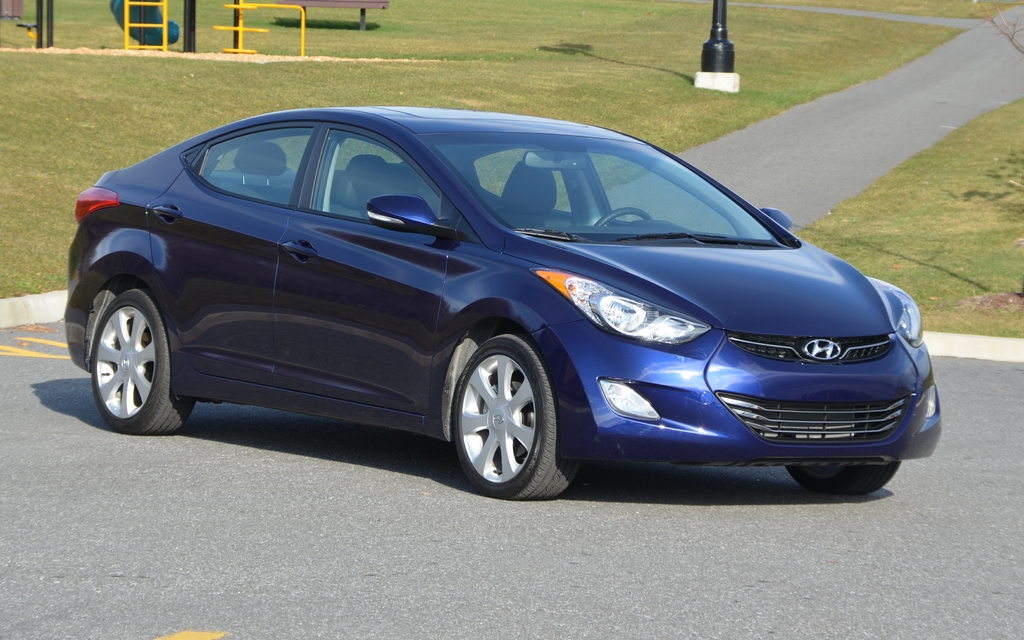2012 Hyundai Elantra: Life After Love

Of all the compact sedans currently on the market, the Hyundai Elantra is, according to a lot of people, one of the most attractive. And even those who don’t agree have to admit that its dynamic style garners attention. The cabin is also a crowd-pleaser, with a user-friendly and ergonomic dashboard, good quality materials and careful assembly.
Although there are very few drawbacks to this car, there are nonetheless a couple worth mentioning… I, for one, don’t care much for the Elantra’s seats (in general, Korean seats and I don’t tend to get along). I find them too hard and too flat, especially the leather ones. However, I’ve met quite a few Elantra owners who disagree with me. I guess it’s just a matter of personal preference. Hopefully you won’t get stuck sitting on the back bench, though, as it’s particularly hard. You also have to be careful not to bash your head on the downward-sloping roof while getting in. But you can be sure about one thing when it comes to the Elantra’s heated seats – they take heat seriously! In fact, the two settings are: warm and scalding! Note that the GLS and Limited versions feature heated rear seats, an added perk that passengers quickly warm up to. The Limited also comes completely swathed in leather, which I don’t necessarily think is a good thing, as the leather-bound steering wheel is way too slippery.
The Elantra features plenty of storage compartments, the radio sound system is all right (for a Hyundai, meaning that it’s better than a Honda, but not as good as a Ford) and the passenger compartment is very spacious, especially in front. The trunk also offers quite a few litres of space, but it would have been nice if the rear seats folded down flat. You can’t have it all!
What’s under the hood?
At the heart of this pretty creature is a 1.8L 4-cylinder engine that produces 148 hp and 131 lbs.-ft. of torque. Buyers can choose to pair it with either a six-speed manual or automatic gearbox. The manual equips the L, GL and GLS trims while the automatic comes factory standard on the Limited only and is available on option for the others. This is a FWD vehicle.
The 1.8L engine offers enough power for your everyday needs. However, don’t expect it to live up to the expectations set by the vehicle’s physique. Its accelerations aren’t strained, but they aren’t very energetic either. We never did manage to go from 0-100 km/hr in under 10 seconds. If the engine had done the sprint more quietly we might have been more forgiving with it… On the other hand, pick-up between 80 and 120 km/hr was more convincing at just 7.5 seconds. But even then, the engine had to have its say about it. If saving on gas is of interest to you, press the Active Eco button. But keep in mind that this function will further handicap the vehicle’s performance.
We test drove an Elantra Limited with an automatic gearbox (the only transmission offered on this model). The gears were well spaced and shifting was well-timed and smooth. You can always shift manually if you want, but I personally don’t see the point unless you’re towing a load through the mountains. During our week-long test period, this Elantra drank 8.0 L/100 km, which seemed a bit much to me, especially considering that several other journalists have recorded between 6.9 and 7.2 L. And yet, I took it on my usual run of 80% secondary roads and highways, combined with 20% city driving. My driving style didn’t change either. Must have been something in the stars, I guess.
Don’t get too crazy
The disc brakes on all four wheels did a great job and demonstrated real authority. At least, that’s the impression they gave off. In actual fact, however, when AJAC (Automobile Journalists Association of Canada) tested the Elantra, they found that it took 44.6 metres to come to a complete stop, while the average for compact sedans is 42.5 metres. The Elantra’s chassis is very rigid, while the steering is over-assisted and feedback is passable, but could be a little better. The suspension (MacPherson strut in front and torsion beam in back) is not as responsive as you might hope. On imperfect road surfaces (yes, you know the ones I’m talking about), the suspension can be overly compliant then suddenly jarring when you hit a pothole. But most of the time, it does a good job. Meanwhile, its directional stability is perfect, even at illegal highway speeds. But I should mention that our vehicle was outfitted with ContiproContact (215/45R17) tires instead of the poor Kumho Solus tires that Hyundai inflicts on all too many of its vehicles.
Not the steal of the century, but still a good deal
When it comes to $$$$$, Hyundai no longer offers the sweet deals it once did. The brand’s vehicles now feature improved fit and trim, with the added plus of improved reliability. And all of this is reflected in the price. The Elantra is no exception to the price hike, but it’s still in line with the category average. Gone are the days when people bought Hyundais because they couldn’t afford anything else!
The Hyundai Elantra is a very good car on many counts and can hold its own when compared to many other compact sedans, including the Chevrolet Cruze, Ford Focus, Kia Forte and Toyota Corolla. You just can’t let its muscular body fool you. The Elantra is much more of a couch potato than a star athlete. If that’s what you’re looking for, go for it!









